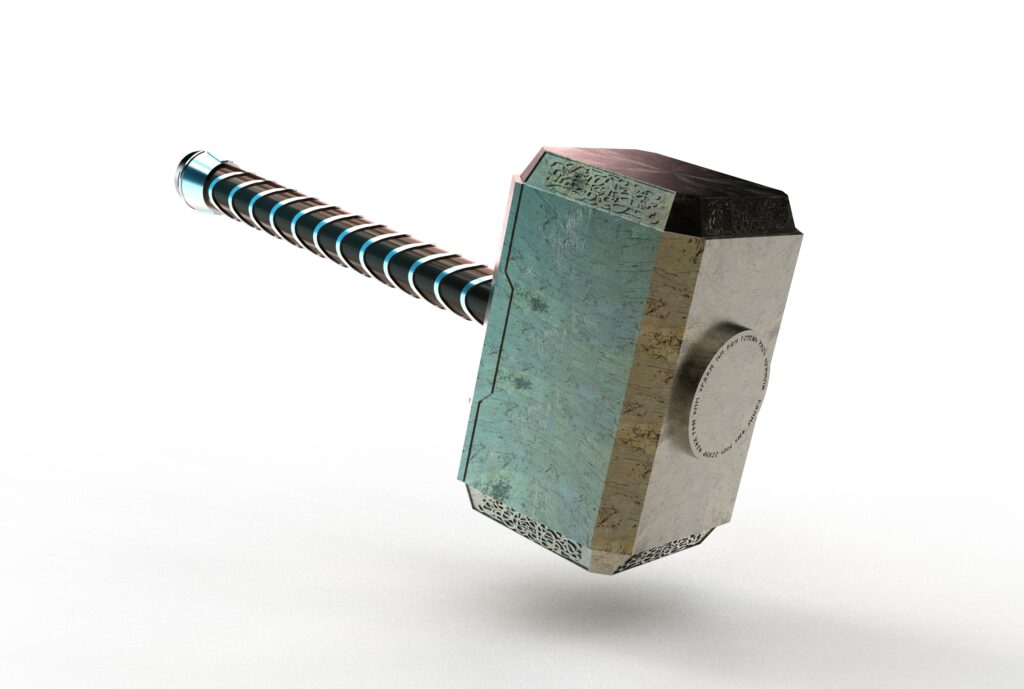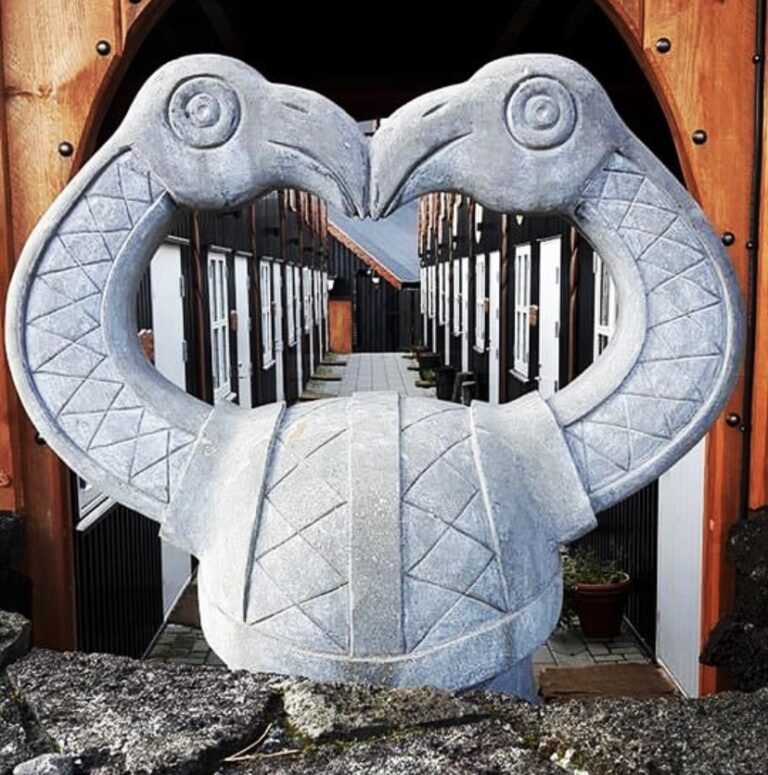Powerful Weapons: Thor’s Hammer Mjolnir

Every country, or culture, comes to have symbols that are deeply connected to their roots, and identity. Here in Canada, we’ve got the moose, likely dressed in an RCMP costume. We have symbols that are closely associated with what we believe represent “Canada” to this outside world. In modern day Scandinavia, you will find much of the same. Thor’s hammer Mjolnir (Mjölnir) represents the norse mythology. But it no longer is viewed by the masses as a religious symbol. Mjolnir is often purchased as a keepsake. It has become popularized in modern times by Marvel Comics, and the entire Marvel Universe. It is also used by those who follow pagan practices today. However, we have to accept that resurgence of interest in Viking mythology is always assisted by pop culture interests.
From Mighty Religious Symbol to Trinket
You cannot walk into any gift shop on the main street in Iceland, Denmark, or Norway without seeing remnants of the mighty Thor. But there you won’t see the comic books with Captain America, and Thor on the front. Instead you will see replicas of the iconic weapon. They are modelled from authentic pieces that have been unearthed throughout the Viking world.

Thor’s hammer necklace, or simply a Mjolnir pendent is a wildly popular keepsake for travellers. People yearn to keep a piece of the Norse God of Thunder with them. When they return to their everyday lives they have a tiny reminder of power. But where did the power of Thor come from? How is he different that the other Norse Gods? Did he ever exist? These are some questions this post will elaborate on.
Historical Context versus Popular Notion
Sometimes we put our trust in pop culture to give us the real story. This is a blessing and a curse. While pop culture references usually contain some truths, they employ a lot of creative license. This post is going to take a step back from the Marvel cinematic universe. I am going to start way back at the beginning of the Viking Age. Hopefully we can glean something about the God of hammers and make some sense of his popularity.
When we look for references to something as specific as Thor’s hammer, we are limited by the passage of time. There are mainly two sources from which we derive information about the importance of this mighty weapon . We are fortunate to have so much existing literature that comments on Norse mythology. We also have the archeological records that have unearthed the symbol in various places throughout the Norse world.

Hammer of the Thunder God
An early mention of Thor’s weapons comes from the Poetic Edda, a collection of poems compiled in the 13th century. Thor and his hammer appear in the eddic poems Vafþrúðnismál, Hymiskviða, Lokasenna, and Þrymskviða. Below I am going to give a brief description of where we see his hammer in action in each story.

From the Literature
Most mentions are brief. Vafþrúðnismál briefly mentions Mjolnir. During Ragnarok, it is said the sons of Thor will use the magic hammer. Ragnarok is of course the final battle that will lead to the end of the world.
The Hymiskviða poem we hear about the Gods receiving a huge caldron from a mountain-giant, sometimes referred to as Aegir, which he uses to brew ale for the gods. But in the same poem we hear of Thor using Mjolnir to destroy “malicious” giants who are causing trouble.
In Lokasenna, we see Loki (the trickster) exchanging insults with the other gods. This is something that seemed to occur pretty often amongst the gods, and was almost like a battle of wits. They often exchanged insults in the form of poetry stanzas which would attack the character of each other. Kind of like a modern day rap battle.
In Þrymskviða, we hear the tale of Thor waking up to find his Mjolnir hammer missing. He tells Loki that it is gone, and Loki decides to borrow a magical cloak, or garment from the Goddess Freyja and uses it to fly to Jotunheimr, (the giants realm) where he talks to Þrymr, a giant who confirmed that he did in fact steal the hammer. He agrees to return it, only if someone will bring him the Goddess Freyja to be his wife. This is the second time I can think of that Freyja has been requested as a wife in a trade between giants and Gods. Not cool guys.
Breaking down Þrymskviða
It initially sounds like they are going to trade Freyja for the hammer, since Thor and Loki tell her to throw a marital head dress on and come with them to Jotunheimr. Rightly so, Freyja flips her lid, and is so angry it says the hall shakes around her. You go girl.
The boys now need to come up with a different method of getting Thor’s hammer back. Loki convinces Thor to dress in the bridal head wear and Loki will dress as a maid and accompany him.
Gender Fluidity in the Sagas
There are actually many studies that have been conducted on the fluidity of gender in many of the sagas. We often see Loki not only pretending to be a woman, but at times even producing children. In the actual version of Þrymskviða, I think we get an interesting glimpse of the masculinity associated with Thor, since he is quite uncomfortable to pretend to play Freyja, even when the entire existence of Asgard is at stake.
He of course complies, yet the giant who eagerly awaits his bride comments that Freyja is awfully ferocious, eating and drinking in a fashion that again, doesn’t strike them as entirely ladylike. Loki says she was so eager to come to Jotunheim that she hadn’t eaten in eight days. The giant lifts her veil and thinks she is kind of off putting physically, with flaming eyes that look enraged. Loki again assures him that is only because she hasn’t slept in anticipation.
So the giant, who perhaps purposely (doesn’t sound too smart in this story) says ok cool, lets bring the hammer over and anoint this woman. Of course then Thor sees his hammer he grabs it and “pummels” the giants and all the wedding guests, without hesitation.
The sagas are interestingly absent of emotion, so you don’t get any details of how a person felt. Instead we need to rely on action and reaction to derive emotion. We can see from some of Thor’s hesitancy that he is not as comfortable with gender fluidity as Loki seems to be.
Archeological Finds
There are about 1000 hammer pendants in various shapes and evolving forms that have been found throughout the Viking world in northern Europe. Most of the hammers are made of a very simple design, and cast from iron or silver. There are only about 100 that are more intricately designed. This makes sense when you think of the cost that would be associated with casting these pendants by hand, and the increased cost of adding a decorative design. There are fewer wealthy people in all societies, therefore, fewer special items that are meant for the upper class.
The hammer has also been found on coins reaching as far as the Arab world. This supports what is already known about the Vikings extending their influence into the far reaches of the known world at the time.
There are standing stones, as well as rune stones, as well as statutes believed to represent Thor. The Eyrarland statute which was found near Akureyri, Iceland is also a wildly popular keepsake found in most gift shops, certainly throughout Iceland’s main street. It is believed to be Thor clutching his hammer, and would have been a simple idol, much like we would keep a crucifix in a Christian home today.
Popular Tattoo

I am always surprised by how many people have tattoos that are derived from Old Norse mythology and are mostly unaware of their meaning. A mutual friend once introduced me to a man and said “you will get along, he likes Viking stuff too”. I saw right away that he had a massive Mjolnir tattoo on his arm. It was quite decorative, with what I would call a celtic knot design inside of it. This wouldn’t be unheard of, as there was certainly a celtic influence in the Northern world during the Viking Age. When questioned on his connection to Mjolnir, I was surprised to find out he only knew it from the Marvel movies, and while he was a fan of Thor’s mythology, he wasn’t actually familiar with any of the historical context.

It is fair to say you will come across a lot of people who are familiar with the popular culture introduction to history. I have always loved this connection and value it. I think diving into the cinematic world of Marvel comicbooks, and falling in love with a character or culture is a great way to start. Taking that interest to the next level might land you somewhere like this blog. If you really want to excel and check out the actual sources, then you can direct yourself to the National Museum of Iceland at: https://www.thjodminjasafn.is/english/
You can also check out Norse Mythology by Charles Kovacs for some more information on Thor and his hammer.
- If weapons interest you then go check out my post on Gungnir, the spear of Odin.
- You can also just go browse all the Symbols and Meanings for more info on Viking symbology.






